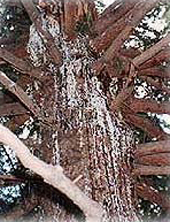Blog
Cytospora
Combat Pathogens that Attack Your Trees
 Cytospora canker is caused by various species of the fungus Cytospora. These pathogens affect many species of trees and shrubs, including aspen, cottonwood and other poplars, apple, birch, willow, mountain ash, silver maple, spruce and Siberian elm. Some Cytospora species are host specific and will not spread to other tree species while others can infect several different trees. For example, cottonwood and aspen are susceptible to one species while willow, green ash, alder and elm are attacked by other species that are host specific.
Cytospora canker is caused by various species of the fungus Cytospora. These pathogens affect many species of trees and shrubs, including aspen, cottonwood and other poplars, apple, birch, willow, mountain ash, silver maple, spruce and Siberian elm. Some Cytospora species are host specific and will not spread to other tree species while others can infect several different trees. For example, cottonwood and aspen are susceptible to one species while willow, green ash, alder and elm are attacked by other species that are host specific.
The fungus attacks trees or parts of trees that are injured, in a weakened, or stressed condition. It grows in the living bark and wood and kills by girdling the branch or tree. The fungus can attack tree bark during the fall-winter-spring seasons when temperatures are warm. The tree, at this time of year, is dormant and cannot defend itself. Trees affected by drought, late spring frosts, insect and fungi defoliation, sunscald, herbicides, or mechanical injury are also susceptible to Cytospora infection. The disease especially affects trees with root damage, which are often found in areas under construction, or trees that recently have been transplanted.
 The symptoms of this disease are yellow or orange-brown to black discoloured areas on the bark of the trunk and branches. Liquid ooze on aspen and gummy ooze on peach and cherry are common. Cankers, sunken dead areas of bark with black pinhead-sized speckling or pimples, may be evident. Reddish-brown discoloration of the wood and inner bark may also be evident. On spruce trees, the disease appears as sunken, resinous areas surrounded by a swollen callus giving a gall-like appearance. Once the branch is girdled, needles may yellow or ridden with the branch eventually dying. Large amounts of resin flow from infected areas coating branches and stems. Unless you see sunken areas surrounded by a swollen callus, resin flow on spruce may indicate that other stresses, diseases or insects are affecting the tree. Because this canker disease usually occurs on a weakened host, the first and foremost method of control is to prevent stress on the tree.
The symptoms of this disease are yellow or orange-brown to black discoloured areas on the bark of the trunk and branches. Liquid ooze on aspen and gummy ooze on peach and cherry are common. Cankers, sunken dead areas of bark with black pinhead-sized speckling or pimples, may be evident. Reddish-brown discoloration of the wood and inner bark may also be evident. On spruce trees, the disease appears as sunken, resinous areas surrounded by a swollen callus giving a gall-like appearance. Once the branch is girdled, needles may yellow or ridden with the branch eventually dying. Large amounts of resin flow from infected areas coating branches and stems. Unless you see sunken areas surrounded by a swollen callus, resin flow on spruce may indicate that other stresses, diseases or insects are affecting the tree. Because this canker disease usually occurs on a weakened host, the first and foremost method of control is to prevent stress on the tree.
Drought and oxygen starvation of roots by flooding soil with water are the two most common stresses that predispose trees to Cytospora infection. To help a tree resist infection, fertilize and water properly for winter and summer, prune, and avoid injury to the trunk and limbs. Proper care of recently transplanted trees is also essential to avoid stress and infection. Wounds caused by lawnmowers and weed trimmers are prime targets for infection on trees in landscaped areas. Insects, such as oyster shell scale, stress the tree and predispose it to Cytospora infection. Insects should be controlled to prevent mortality by the combined stress of the insects and Cytospora canker. It is still important to keep all trees healthy since resistant trees may still become infected if severely stressed.
To learn more, contact us today
Source: Colorado State University

